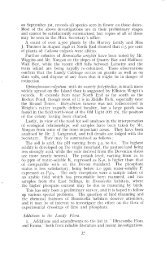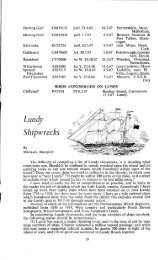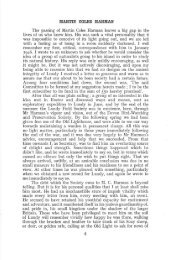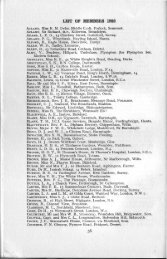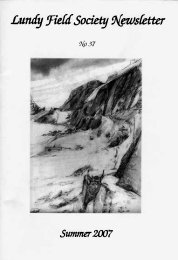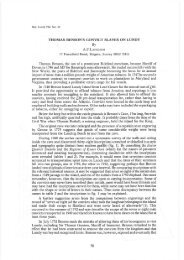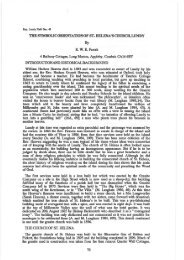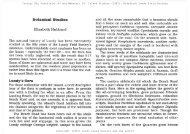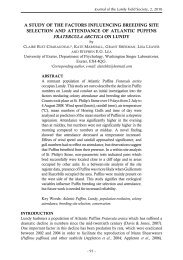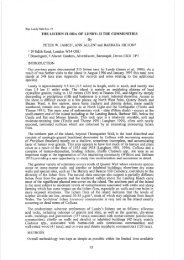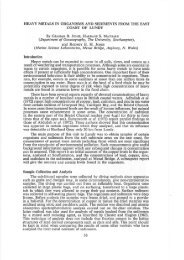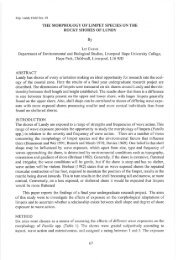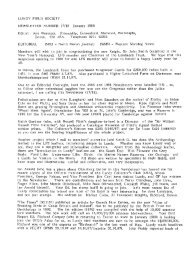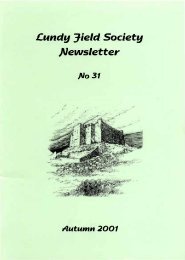BIRDS RECORDED IN 1962 The season turned out to be a ... - Lundy
BIRDS RECORDED IN 1962 The season turned out to be a ... - Lundy
BIRDS RECORDED IN 1962 The season turned out to be a ... - Lundy
Create successful ePaper yourself
Turn your PDF publications into a flip-book with our unique Google optimized e-Paper software.
<strong>BIRDS</strong> <strong>RECORDED</strong> <strong>IN</strong> <strong>1962</strong><strong>The</strong> <strong>season</strong> <strong>turned</strong> <strong>out</strong> <strong>to</strong> <strong>be</strong> a most interesting one with many of the rarer<strong>Lundy</strong> visi<strong>to</strong>rs appearing. In all 137 species were recorded including oneprobable sub-species of Calandra Lark but as this may turn <strong>out</strong> <strong>to</strong> <strong>be</strong> a newrecord for Europe all details are <strong>be</strong>ing held over until the record has <strong>be</strong>enconfirmed or dismissed.<strong>The</strong> interest and help of the Islanders, as well as the observations of visitingmem<strong>be</strong>rs, has <strong>be</strong>en most valuable particularly on those occasions when singlebirds were concerned.An extremely helpful visit was made by Kenneth Williamson, MigrationResearch Officer from the B.T.O., who offered some sound advice and pointed<strong>out</strong> a few of the irregularities in recording and running. At his suggestiona breeding census of the passerine birds will <strong>be</strong> the main project next year.A small group came over from Jesus College, Oxford, and amongst otherstudies under<strong>to</strong>ok a complete census of the sea-bird population and a particularstudy of the first flighting of young auks and their preda<strong>to</strong>rs.Before the main list of species I am including a few notes on the Winterof 1961 <strong>to</strong> <strong>1962</strong>, taken from observations made by John Ogilvie.<strong>The</strong> winter was <strong>out</strong>standing for the very large num<strong>be</strong>rs of birds on theIsland during an exceptionally cold spell at the <strong>be</strong>ginning of January. <strong>The</strong>ground was covered, with even Waders feeding at the bird table in the HotelGarden. <strong>The</strong> predominant species were Lapwings, Curlew, Snipe, Redwing,Fieldfare and Starlings which stayed until ab<strong>out</strong> sth January but many diedand the Ravens were seen <strong>to</strong> peck many Lapwings <strong>to</strong> death as they satexhausted on the ground.An interesting record was of a White-fronted Goose which stayed with thetame geese in the Ducks' Pen from <strong>be</strong>fore Christmas in<strong>to</strong> the New Year.<strong>The</strong> Observa<strong>to</strong>ry was manned from 7th March until zgth Novem<strong>be</strong>r.Great Northern Diver. One present off the East Side from 21st <strong>to</strong> 24th May.Red Throated Diver. One off East Side on 23rd May. Two near the Islandon the crossing of 3oth August. (]. CoLEMAN CooKE.)S<strong>to</strong>rm Petrel. One off-shore on 14th June and the remains of one werefound at North End in the <strong>be</strong>ginning of July. No evidence of breeding.Manx Shearwater. <strong>The</strong> first ones were h eard around the Terrace area on22nd April and then regularly, although not in any great num<strong>be</strong>rs, throughMay and June <strong>to</strong> mid-July at many points around the s<strong>out</strong>hern half of theIsland. Flocks of up <strong>to</strong> fifty could <strong>be</strong> seen from East Side and over the Raceon most evenings from mid-June onwards. Not recorded after 28th July andnone were found on land apart from two that <strong>be</strong>came stranded in S<strong>out</strong>hLight compound.Fulmar Petrel. Birds were on the cliffs when the Observa<strong>to</strong>ry opened andbreeding <strong>to</strong>ok place on Gannets' Rock and at Jenny's Cove. Not recordedafter mid-Septem<strong>be</strong>r.Gannet. Birds were seen in most months but most regularly during Augustand Septem<strong>be</strong>r and sometimes fishing quite close <strong>to</strong> the Island. <strong>The</strong> largestnum<strong>be</strong>r recorded was twenty-five <strong>to</strong>gether on 27th May.Cormorant. One or two from April <strong>to</strong> August from Surf Point around <strong>to</strong>Montague Steps. No nest was found. A flock of fifteen flying SW. across theS<strong>out</strong>h End on zgth August and five off East Side on 13th Septem<strong>be</strong>r were theonly movements recorded.Shag. Present all year but only in very small num<strong>be</strong>rs after mid-Septem<strong>be</strong>r.Heron. Single birds recorded z8th <strong>to</strong> 29th March, 3oth April, 24th May,1oth August and two <strong>to</strong>gether on 13th Novem<strong>be</strong>r.6
Mallard. Four pairs bred and a clutch was deserted. Some of the ducklingsdisappeared, presumed <strong>to</strong> <strong>be</strong> taken by gulls, and a few died from other causesbut by the end of the year num<strong>be</strong>rs up <strong>to</strong> twenty-five were recorded regularly.Teal. A male and a female from 15th <strong>to</strong> 31st March, either singly or t ogetherbut on 22nd there were two males and a female. A female was recorded untiluth April. Two on 2oth August. R ecorded from 1oth Septem<strong>be</strong>r <strong>to</strong> the endof Novem<strong>be</strong>r, usually up <strong>to</strong> three birds but seven on 22nd and four on 23rdSeptem<strong>be</strong>r.Wigeon. A female lived with the Mallard in the Ducks' Pen from 13thOc<strong>to</strong><strong>be</strong>r until the <strong>be</strong>ginning of Novem<strong>be</strong>r when it moved <strong>out</strong> <strong>to</strong> Pondsbury.It was joined on 13th Novem<strong>be</strong>r by a male and a second female, thereafteronly a ma le and female until 17th Novem<strong>be</strong>r.Goose sp. Three grey geese in Middle Park on 28th Oc<strong>to</strong><strong>be</strong>r. <strong>The</strong>y were notidentified as they were far off against the light and immediately left the Island,heading NW. against a strong wind.Whooper Swan. Two adult birds on Pondsbury on 25th Novem<strong>be</strong>r . <strong>The</strong>yremained on the Island after the Observa<strong>to</strong>ry closed for some weeks.Buzzard. One pair all the year. A nest with three eggs was found on 9th Mayon East Side cliffs. By 27th May only two eggs were left and the bird was notsitting. All the eggs had gone by uth June.Sparrow Hawk. Only one bird, usually hunting along East Side, <strong>be</strong>tween3rd and sth Novem<strong>be</strong>r.Montagu's Harrier. A Harrier was seen in Tillage Field on 7th May byMr Harman and later good views were obtained along East Side by most ofthe Islanders and visi<strong>to</strong>rs. It was a female bird and, was not seen after 12th May.Hobby. A single record on 28th April near <strong>The</strong> Ugly. (M. and V. SQUIRES.)Peregrine Falcon. N o evidence of breeding . Single birds on a few dates inmost mont hs but t wo seen on 14t h a nd 15th May and on 19th June. Threedistur<strong>be</strong>d from Tib<strong>be</strong>tt's Point on 7th June one of which may have <strong>be</strong>en animmature bird.Merlin. Three records of single birds. A male on 21st and a female on 24thApril ; a female on 2oth Septem<strong>be</strong>r.Kestrel. Possibly two pairs bred, in the Quarry area and <strong>be</strong>yond H alfwayWall. R ecorded through<strong>out</strong> the <strong>season</strong> with the highest num<strong>be</strong>rs noted afterthe end of August, the most <strong>be</strong>ing seven on sth Septem<strong>be</strong>r but often up <strong>to</strong> five.Pheasant. Seen at all times along East Side and frequently feeding in TillageField. <strong>The</strong> most seen <strong>to</strong>gether was two males and four females. <strong>The</strong> speciesbred.Water Rail. One or two in Millcom<strong>be</strong> st ream until 2oth April. <strong>The</strong> firstAutumn bird was seen on 18th Septem<strong>be</strong>r and thereafter recorded in Millcom<strong>be</strong>or around the Farm and occasionally at Pondsbury. <strong>The</strong> most counted wasfive on 24th Oc<strong>to</strong><strong>be</strong>r .Corncrake. Single birds recorded on 27 th May, 13th June and 6th Septem<strong>be</strong>r.Oystercatcher. Recorded until t he end of August . Ab<strong>out</strong> eight pa irs bred.Sma ll fl ocks of up <strong>to</strong> nine were recorded d uring t he autumn, but ninet een on28t h Oc<strong>to</strong><strong>be</strong>r, a nd only very few in Novem<strong>be</strong>r .Lapwing. F a irly large num<strong>be</strong>rs in Ma rch, flocks varying from twelve <strong>to</strong>peaks of roo on 12th, rzo on 24t h and 130 on z6th. Ab<strong>out</strong> twelve or fourteenpairs bred around the eastern half of Quarter Wall and the first nest was found'on qth April. None after the <strong>be</strong>ginning of August until two on roth Septem<strong>be</strong>r.From then only small flocks, mostly one <strong>to</strong> four but twelve on 16th Septem<strong>be</strong>rand eighteen on 13th and 14th Oc<strong>to</strong><strong>be</strong>r, until 24th Oc<strong>to</strong><strong>be</strong>r when thirty-onewere present. Largest autumn num<strong>be</strong>rs were sixty on 9th and sixty-three onroth Novem<strong>be</strong>r.c7
Ringed Plover. A few during April ; three on 13th and one from 14th <strong>to</strong> 17th.Up <strong>to</strong> two first winter birds <strong>be</strong>tween 6th and zznd Septem<strong>be</strong>r on the LandingBeach.Golden Plover. A flock of varying size was present on the Airfield all Marchuntil znd April. Two on 7th March then twenty from gth <strong>to</strong> 13th increasing<strong>to</strong> fifty-five from 15th <strong>to</strong> 17th, two on r8th building up <strong>to</strong> eighty by 24th anddown <strong>to</strong> three by znd April. A few birds r oth <strong>to</strong> 24th April, but twenty-fiveon 14th. Single birds through May. One on 3oth August then small num<strong>be</strong>rs<strong>to</strong> end of <strong>season</strong>, largest num<strong>be</strong>rs <strong>be</strong>ing four on 17th Septem<strong>be</strong>r, twelve onr8th Oc<strong>to</strong><strong>be</strong>r and six on uth Novem<strong>be</strong>r.Dotterel. Single birds. One on 29t h April on the Airfield and on r2thSeptem<strong>be</strong>r above the Terrace.Turns<strong>to</strong>ne. Seven on 23rd April, one on 14th July, two on 15th and 3othAugust, three on 7th and four on gth and 13th Septem<strong>be</strong>r, singles on 4th andrzth Novem<strong>be</strong>r. Most of these birds were seen <strong>be</strong>hind Rat Island and thespecies were almost certainly present more often and overlooked .Snipe. Recorded in small num<strong>be</strong>rs up <strong>to</strong> five th rough March and Apriluntil 4th May, but thirteen on r6th, forty-eight on 23rd, sixteen on 24th,fourteen on 26th and thirteen on 3oth March, nine on rst and seven on rothand uth April. Singles 14th, 17th and 23rd May. R ecorded again from 27thJuly <strong>to</strong> end of <strong>season</strong>, in small num<strong>be</strong>rs, with p eaks of fifteen on 14th Augustand eleven on 26th Oc<strong>to</strong><strong>be</strong>r.dack Snipe. A single bird on 23rd, 26th and 3oth March in Quarter Wallrushes. In the autumn three on 23rd and one on 25th Septem<strong>be</strong>r in P onds bury.Woodcock. Up <strong>to</strong> two recorded through March. In autumn, mostly singlebirds from 17th Oc<strong>to</strong><strong>be</strong>r <strong>to</strong> end of <strong>season</strong>, but two on 24th and three on 27thOc<strong>to</strong><strong>be</strong>r.Curlew. Recorded in every month. Twenty-four on uth March and eigh<strong>to</strong>n 16th and 17th but otherwise only in small num<strong>be</strong>rs up <strong>to</strong> six until the endof June. One pair strongly suspected of breeding on Ponds bury area but nonest or young were found. N um<strong>be</strong>rs <strong>be</strong>gan building up from twenty-eight on28th June <strong>to</strong> 120 on IIth a nd 12th July . A few flocks during August. thirty-twoon 3rd, sixteen on 21st and forty-five on z6th and 27th. <strong>The</strong>reafter only smallnum<strong>be</strong>rs <strong>to</strong> the end of <strong>season</strong>, highest <strong>be</strong>ing fo urteen on u th and twenty-fiveon r zth Septem<strong>be</strong>r.Whimbrel. Two on 17th April building u p t o fou rteen by z8th and thir ty-twoby 3rd May and then in varying num<strong>be</strong>rs un til down <strong>to</strong> ten by 17th May andonly a few birds u n til 2nd June. Sixteen again on 2rst July, eight from 27tht o 29th and then twent y on 3rd August. Only one or t wo birds throughSeptem<strong>be</strong>r and occasionally in Oc<strong>to</strong><strong>be</strong>r with a last record on 29t h Novem<strong>be</strong>r.Bar-tailed Godwit. Two with Whimbrel in Middle P ark from 28th April<strong>to</strong> 3rd May.Green Sandpiper. Two from 26th <strong>to</strong> 29th July then single birds on 14th,23rd and 24th August and on znd Septem<strong>be</strong>r.Wood Sandpiper. One from 1st <strong>to</strong> 8th Septem<strong>be</strong>r.Common Sandpiper. One or two birds from 14th April <strong>to</strong> 4th May and fiveon 14th July decreasing <strong>to</strong> three by 18th. Singles on 21st and 27th August.Redshank. Single birds on the following dates : rzth, 13th and zzndApril; 8th and r2th May; 13th and 14th July; z8th Oc<strong>to</strong><strong>be</strong>r and 3rdNovem<strong>be</strong>r.Spotted Redshank. Two on Pondsbury on 3oth August.Greenshank. Three on 14th and single birds on 15th, r8th, 26th and 31stAugust. A single bird flying over on gth Oc<strong>to</strong><strong>be</strong>r.Knot. A single bird at Pondsbury on 24th August.8
Purple Sandpiper. A single bird on 28th August.Little Stint. A single bird on Pondsbury and later Quarter Wall Pond on13th Oc<strong>to</strong><strong>be</strong>r. It was remarkably tame.Pec<strong>to</strong>ral Sandpiper. One on the Island from 2nd <strong>to</strong> 8th Septem<strong>be</strong>r.Dunlin. Four from 2oth <strong>to</strong> 22nd March and two on 26th. Regular <strong>be</strong>tweenqth and r8th April, with fourteen on 16th, and from 27th April <strong>to</strong> 8th Maywith a maximum on 4th. One on 28th May. Up <strong>to</strong> seven during August andthen every day from 2nd <strong>to</strong> 24th Septem<strong>be</strong>r with four from rsth <strong>to</strong> 17th. Lastsingle birds on 24th and 31st Oc<strong>to</strong><strong>be</strong>r.Ruff. A single bird at Pondsbury on 30th August and one on the Airfield22nd and 23rd Septem<strong>be</strong>r.Pratincole. On z6th April a strange bird was seen in the region of QuarterWall by a group of students from Bris<strong>to</strong>l University and R. Carden, assistantwarden at that time. Both parties arrived at an independent identification ofthe bird as a Pratincole. Despite searching the bird was not seen again. (Thisrecord has not yet <strong>be</strong>en passed by the rarities committee.)Great Black-backed Gull. Recorded all year but with num<strong>be</strong>rs decreasingfrom the end of August leaving only six at the end of <strong>season</strong>.Lesser Black-backed Gull. Present until zsth Septem<strong>be</strong>r but with num<strong>be</strong>rsdecreasing after the end of August. Fifty-four still present on r6th Septem<strong>be</strong>rand down <strong>to</strong> seven by 24th.Herring Gull. Present all year but with num<strong>be</strong>rs decreasing after the endof August.Common Gull. Two on 1st August over Landing Bay and two in S<strong>out</strong>hWest Field on zoth Septem<strong>be</strong>r.Black-headed Gull. Two on zznd March. One immature from 14th <strong>to</strong> 17thApril and single birds zgth May, zrst and 30th June, 4th and gth July. Twoon 3rd August, 15th and zoth Septem<strong>be</strong>r, three on 21st and twelve during as<strong>to</strong>rm on z8th Septem<strong>be</strong>r.Kittiwake. Present in March and last recorded on 24th August.Common Arctic Tern. One on zoth May. One on 3rd and six on· 16thSeptem<strong>be</strong>r. A single on 23rd Oc<strong>to</strong><strong>be</strong>r. All were seen around the Landing Bay.Razorbill. Recorded in March but no num<strong>be</strong>rs on the ledges until 1oth April.Many birds had left by the end of July and all had gone by the first fortnigh<strong>to</strong>f August.Guillemot. A few birds were present in March and many of them wereoiled. No num<strong>be</strong>rs appeared on the ledges until roth April. Many had left bythe end of July and none were left after the first fortnight in August.Puffin. <strong>The</strong> first ones were seen off North End on rzth April when twentyfivewere counted and the last ones were recorded at the end of July.Wood Pigeon. Num<strong>be</strong>rs up <strong>to</strong> nine every day until 17th June, but up <strong>to</strong>sixteen from rgth <strong>to</strong> zznd April a nd 6th <strong>to</strong> 8th May. Sixteen on rzth andeighteen on 16th June then seen irregula rly until 1oth Septem<strong>be</strong>r with largestnum<strong>be</strong>rs in mid-August when up <strong>to</strong> twenty-five were seen. Regular again fromroth Septem<strong>be</strong>r <strong>to</strong> zsth Oc<strong>to</strong><strong>be</strong>r, generally up <strong>to</strong> eight but up <strong>to</strong> fifteen duringmid-Septem<strong>be</strong>r and seventeen on 13th Oc<strong>to</strong><strong>be</strong>r. Breeding <strong>to</strong>ok place along EastSide but a deserted nest in the m<strong>out</strong>h of Terrace Trap was the only one found.Turtle Dove. Single birds on zoth and z8th April and then almost daily atBimjamin's Chair <strong>be</strong>tween 1st and 12th May with a maximum of eight on4th. Single birds 15th and zgth and two on 31st May and then every day from4th <strong>to</strong> 17th June, usually up <strong>to</strong> nine birds but with sixteen on 7th. Singlebirds again <strong>to</strong>wards the end of the month on rgth, z8th and zgth. Two onro:h July and single birds 3oth August and 15th Septem<strong>be</strong>r.9
Cuckoo. <strong>The</strong> first bird on qth April and then three on r6th. Regular from..!4th April until rgth June; generally up <strong>to</strong> four birds but seven on rgth Mayand six on gth June; and again from 25th <strong>to</strong> 30th June with three on 27thand z8th. Two birds from rst <strong>to</strong> roth and one until 13th July. A juvenile<strong>to</strong>wards the end of the month and one from rrth <strong>to</strong> r8th August.Long-eared Owl. A lone bird was present around Millcom<strong>be</strong> from 25th <strong>to</strong>27th May.Short-eared Owl. Records of single birds only ; roth and rrth March, rgthApril and 2oth May and in autumn 14th and rsth Oc<strong>to</strong><strong>be</strong>r and 25th Novem<strong>be</strong>r.Nightjar. A single bird on rgth and 23rd May and one was heard 'churring'<strong>be</strong>low the Hotel Garden an several evenings <strong>to</strong>wards the end of the month.Swift. First record, four birds seen on zrst April and thereafter regular until6th July with the largest num<strong>be</strong>rs <strong>be</strong>ing counted during the latter half ofJune with roo on 29th. A few through July and August and a single bird on4th and sth Septem<strong>be</strong>r.Alpine Swift. One was seen over Lighthouse Field on 25th April. It flew onslightly NW. and disappeared over West Side. (M. SQUIRES and J. 0GILVIE.)(This record has not yet <strong>be</strong>en accepted by the Rarities Committee.)Hoopoe. Seen on three occasions including one on an unusual date. One inMillcom<strong>be</strong> on z6th April (]. LAMPREY and A. STRICK}, the next was also inMillcom<strong>be</strong>, on roth May (E. BELL) . <strong>The</strong> third was by the Quarries on theevening of 29th August.Great Spotted Woodpecker. One was first seen on 24th Septem<strong>be</strong>r (].LAMPREY) . It stayed and was seen or heard almost every day in any par<strong>to</strong>f the Island where there was a tree or fence post for it <strong>to</strong> work on. On zrstOc<strong>to</strong><strong>be</strong>r two woodpeckers were seen but it is certain that the second birdhad <strong>be</strong>en present for some· time already. <strong>The</strong>n two until 6th Novem<strong>be</strong>r andthereafter just the one bird until 24th Novem<strong>be</strong>r. On <strong>be</strong>ing caught and ringedboth proved <strong>to</strong> <strong>be</strong> first winter birds.Skylark. Ab<strong>out</strong> fifty pairs bred and resident num<strong>be</strong>rs were recorded untilthe <strong>be</strong>ginning of Septem<strong>be</strong>r when only a flock of twenty was present. Flocksof varying num<strong>be</strong>rs up <strong>to</strong> fifty or sixty were present until the <strong>be</strong>ginning ofNovem<strong>be</strong>r and from rsth up <strong>to</strong> four were recorded almost daily.Swallow. <strong>The</strong> first bird a ppeared on gth April and then daily until rzth July.Peak movements were around z rst a nd 22 nd April with birds passing throughmost of the clay although num<strong>be</strong>rs a lways seemed <strong>to</strong> <strong>be</strong> concentrated aroundmidday. Returning birds ha d star ted <strong>to</strong> appear by the end of August but thelargest num<strong>be</strong>rs were <strong>be</strong>tween 13th a nd 24th Septem<strong>be</strong>r. Small num<strong>be</strong>rsthrough Oc<strong>to</strong><strong>be</strong>r and the last records were t wo on 7th and one on 8th Novem<strong>be</strong>r.One pair bred in the Shipwrigh t's Shed and brought o ff a t least t wo young.House Martin. <strong>The</strong> first record was of five on 2rst April and then regularlyuntil 27th June with peak num<strong>be</strong>rs <strong>to</strong>wards the end of April. Occasionallyfrom July until r6th Septem<strong>be</strong>r and then largest autumn movement <strong>be</strong>tween2oth and 22nd Septem<strong>be</strong>r. Only occasionally during Oc<strong>to</strong><strong>be</strong>r with the lastrecord <strong>be</strong>ing of twelve on 24th.Sand Martin. <strong>The</strong> first birds were four on 3rd April and daily <strong>be</strong>tweenrrth and 14th. Regular from r8th April until the end of May with heaviestnum<strong>be</strong>rs at the end of April. A light movement <strong>to</strong>ok place <strong>be</strong>tween 4th and6th June and then twenty on zoth and 22nd July. Fairly regular on s<strong>out</strong>hpassage from zzncl August until 24th Septem<strong>be</strong>r with largest num<strong>be</strong>rs of250 on 3oth August and zoo on zznd Septem<strong>be</strong>r.Raven. Up <strong>to</strong> eight birds and occasionally nine recorded all <strong>season</strong> butten on 27th and twelve on zSth May. <strong>The</strong> maximum seen was of fourteen<strong>to</strong>gether on 31st August. Two nests were found, one in Raven Gully andthe other just s<strong>out</strong>h of Long Roost, but a third pair was probably breedingsomewhere <strong>be</strong>tween Dead Cow Point and Jenny's Cove.10
S<strong>to</strong>nechat. Recorded from roth March until the end of <strong>season</strong> with possiblya slight increase in num<strong>be</strong>rs <strong>to</strong>wards the end of Septem<strong>be</strong>r. At least six pairsbred.Whinchat. Up <strong>to</strong> two birds through May but with four on rst and 25th,and then a single one on 22nd July. In autumn regular <strong>be</strong>tween 3oth Augustand 25th Septem<strong>be</strong>r with a peak of twelve on 3rd and twenty-one on 4thSeptem<strong>be</strong>r.Redstart. <strong>The</strong> first one, a male, on 19th April and five on 2oth then usuallysingle birds <strong>to</strong> 27th May but with six on 23rd. One on 2rst and two on 3othand 31st August. Fairly regularly seen <strong>be</strong>tween 14th and 25th Septem<strong>be</strong>rwith thirteen on 22nd and twelve on 24th. Three on 4th and one on 12thOc<strong>to</strong><strong>be</strong>r were the last records.Black Redstart. A male on 17th April. None until two on 24th Septem<strong>be</strong>rand two <strong>be</strong>tween 8th and 29th Oc<strong>to</strong><strong>be</strong>r. A last one on 3rd Novem<strong>be</strong>r.Robin. Ab<strong>out</strong> four until 2nd May which was the last record until oneappeared on 31st August. <strong>The</strong> most recorded was eight on 22nd Septem<strong>be</strong>r.Grasshopper Warbler. Up <strong>to</strong> two birds daily <strong>be</strong>tween 2rst April and 8th Maybut with six on 24th and 26th April. Five on 22nd Septem<strong>be</strong>r was only autumnrecord.Reed Warbler. Only single birds on three occasions in the autumn, 31stAugust, and 14th and 22nd Septem<strong>be</strong>r.Marsh Warbler. One was caught and ringed on 2nd Septem<strong>be</strong>r. (J. CoLEMANCooKE and P. GRIFFITHs.)Sedge Warbler. <strong>The</strong> first one on 23rd April then regularly until 3oth Maywith peak num<strong>be</strong>rs <strong>be</strong>ing fifty on 2nd and sixty on 19th May. A single birdon 29th July possibly the same one that had <strong>be</strong>en singing in Millcom<strong>be</strong> atthe end of May. None bred. Only a few during the autumn; one on 31st August,one on 2oth and six on 22nd Septem<strong>be</strong>r.Melodious lcterine Warbler. A Melodious Warbler was caught and ringed onrsth Septem<strong>be</strong>r and a similar unringed bird was in Millcom<strong>be</strong> from 2rst <strong>to</strong>24th Septem<strong>be</strong>r.Blackcap. A male on 3rd May and two birds on 4th were the only springrecords. A male from 18th <strong>to</strong> 2rst Septem<strong>be</strong>r then three on 22nd and a femaleon 23rd. Recorded b etween 4th Oc<strong>to</strong><strong>be</strong>r and 14th Novem<strong>be</strong>r, the most <strong>be</strong>ingthree on 8th and 22nd Oc<strong>to</strong><strong>be</strong>r.Garden Warbler. Single birds on 24th and 27th April and 9th May withtwo on 4th May. During the autumn recorded <strong>be</strong>tween 31st August and zzndSeptem<strong>be</strong>r, usually single birds but two on 14th and r6th and three on zzndSeptem<strong>be</strong>r then three on 8th Oc<strong>to</strong><strong>be</strong>r.Whitethroat. A single bird on 14th April and then recorded <strong>be</strong>tween 22ndApril and 14th June with peak movements <strong>be</strong>ing 100 on 2nd and 150 on 19thMay. One pair bred in the Millcom<strong>be</strong> area. Autumn records were <strong>be</strong>tween3oth August and 25th Septem<strong>be</strong>r, peaks <strong>be</strong>ing fifteen in 13th and nineteen on22nd Septem<strong>be</strong>r. A final single bird on 8th Oc<strong>to</strong><strong>be</strong>r.Lesser Whitethroat. Up <strong>to</strong> two birds <strong>be</strong>tween 27th April and 3oth May.A single bird was caught at the Lighthouse on 24th Septem<strong>be</strong>r.Willow Warbler and Chiffchaff. <strong>The</strong> first three birds were seen on 1othApril and one caught proved <strong>to</strong> <strong>be</strong> Willow Warbler. <strong>The</strong> first Chiffchaff washeard on 12th. Num<strong>be</strong>rs rose <strong>to</strong> forty by 13th then a two on 14th; 200 on r8th,fifty on 19th, 150 on 2oth, fifty on zrst, 100 on 22nd and fifty on 25th down <strong>to</strong>twenty by 3oth. A hundred again on znd May down <strong>to</strong> twenty by 8th andthereafter only small fluctuations until the end of May. A lone Chiffchaffwas singing in Millcom<strong>be</strong> until 1st July and another on the Terrace <strong>be</strong>tween12th and 18th June but the species did not breed. <strong>The</strong>re was a movement of12
so <strong>be</strong>tween 28th July and the b eginning of August and then only smallnum<strong>be</strong>rs recorded from zgth August <strong>to</strong> 25th Septem<strong>be</strong>r the most <strong>be</strong>ing fiftyon zznd Septem<strong>be</strong>r. A single bird, most probably a Chiffchaff, was presentall Oc<strong>to</strong><strong>be</strong>r and Novem<strong>be</strong>r with three on 13th Oc<strong>to</strong><strong>be</strong>r. Working from recordsof song and ringing the proportion of Willow Warbler <strong>to</strong> Chiffchaff was in theregion of three <strong>to</strong> two.Yellow-browed Warbler. One was seen in the willows over Quarry Pond on4th and sth Oc<strong>to</strong><strong>be</strong>r and on 6th a similar, probably the same, bird appearedin Millcom<strong>be</strong>. (This record has <strong>be</strong>en accepted by the Rarities Committee.)Goldcrest. A single bird on zsth March and then almost daily from sth <strong>to</strong> I)thApril <strong>to</strong> a peak of fifty on r8th and through a steady decline <strong>to</strong> two on 4thMay. Up <strong>to</strong> four birds <strong>be</strong>tween r8th and 25th Septem<strong>be</strong>r and usually up <strong>to</strong>six from gth Oc<strong>to</strong><strong>be</strong>r <strong>to</strong> the end of <strong>season</strong> but <strong>be</strong>tween zoth an d 27th Oc<strong>to</strong><strong>be</strong>rtwelve were counted.Firecrest. One was seen in Millcom<strong>be</strong> <strong>be</strong>tween 7th and nth Oc<strong>to</strong><strong>be</strong>r butwith two on 8th . A single bird appeared in the Bot<strong>to</strong>m Garden on 6thNovem<strong>be</strong>r.Spotted Flycatcher. Up <strong>to</strong> three birds from z6th April <strong>to</strong> roth May and thenan increase <strong>to</strong> fifteen on zznd and thirty-five on 23rd May, decreasing <strong>to</strong>seven by z8th. A movement of twenty-five on zgth and then down <strong>to</strong> one pair,which bred in Millcom<strong>be</strong> area, by 5th June. <strong>The</strong> first autumn arrival was offifteen on zgth and twenty by 30th August, fifteen again on 31st and thensix birds until zrst Septem<strong>be</strong>r when there was an increase <strong>to</strong> twenty on zznd.A steady decrease <strong>to</strong>ok place until there were two on zgth. <strong>The</strong> last recordsare of two on gth and one on roth Oc<strong>to</strong><strong>be</strong>r.Pied Flycatcher. <strong>The</strong> first one, a female, on zoth April, four on zznd thenup <strong>to</strong> two until 7th May and two on 23rd. Returning birds started with twentyon 30th August decreasing <strong>to</strong> three by rzth Septem<strong>be</strong>r, up <strong>to</strong> fifteen on 13thand down <strong>to</strong> two on zrst, a rise <strong>to</strong> twelve on zznd with only five by z8th andthen single birds on 30th Septem<strong>be</strong>r, 4th, gth and 27th Oc<strong>to</strong><strong>be</strong>r. An exceptionallylate record was of a single bird on 4th and 6th Novem<strong>be</strong>r.Red-breasted Flycatcher. A single bird in Millcom<strong>be</strong> from 8th <strong>to</strong> roth Oc<strong>to</strong><strong>be</strong>rproved <strong>to</strong> <strong>be</strong> a first winter female when caught and ringed.Dunnock. Recorded through<strong>out</strong> the <strong>season</strong> with the indication of possiblemovement in mid-Oc<strong>to</strong><strong>be</strong>r when an unusual concentration of birds was noticea<strong>be</strong>low Halfway \¥all. At least twenty pairs bred, in Millcom<strong>be</strong> and a longthe East Side <strong>to</strong> the T errace.Meadow Pipit. Present all <strong>season</strong> with ab<strong>out</strong> fifty pairs breeding. Autumnmovements <strong>to</strong>ok place during the second half of Septem<strong>be</strong>r, maximumnum<strong>be</strong>rs <strong>be</strong>ing rzo on rgth, zzo on zznd, 132 on 24th, 300 on z8th and thenonly flocks of up <strong>to</strong> forty recorded. Very few birds were present after zothOc<strong>to</strong><strong>be</strong>r.Tree Pipit. <strong>The</strong> first five noted on zoth April and ten on zznd and 23rd,then a few records <strong>to</strong> the end o f the mon t h until six were counted on rst Mayand three on 3rd, then singles on gth a nd z6th. <strong>The</strong> first autumn bird on 7thSeptem<strong>be</strong>r a nd t hen up <strong>to</strong> two <strong>be</strong>tween r6th a nd zrst with three on zznd andfour on 23rd Septem<strong>be</strong>r.Rock Pipit. Present all <strong>season</strong>, always <strong>be</strong>low the <strong>to</strong>p of the Island. Noestimate was made of num<strong>be</strong>rs or breeding.Pied Wagtail and White Wagtail. Pied Wagtail was recorded all <strong>season</strong>until 28th Septem<strong>be</strong>r and thereafter only a single bird but with seven ongth Oc<strong>to</strong><strong>be</strong>r. No obvious movement until 30th August when num<strong>be</strong>rs wentup <strong>to</strong> thirty decreasing <strong>to</strong> four by 3rd Septem<strong>be</strong>r. F ifteen on 5th and thirtysev~non 6th, decreasing <strong>to</strong> eight by nth and up <strong>to</strong> twenty from 13th <strong>to</strong>rsth Septem<strong>be</strong>r. Ab<strong>out</strong> five pairs bred, in the Castle, Church Porch, aroundthe farm and in S<strong>to</strong>nycroft area.IJ
Definite White Wagtails were r ecorded as follows : single birds nth, 22ndand 23rd March ; and gth <strong>to</strong> 3oth April but with four on 14th and a movement,when twelve were counted, on 22nd. A single bird again on 28th May.Grey Wagtail. Single birds during the autumn on 3oth August ; gth, zznd,24th and 27th Septem<strong>be</strong>r, and 8th, gth, 15th and 24th Oc<strong>to</strong><strong>be</strong>r.Yellow Wagtail. Fairly regular in spring <strong>be</strong>tween rgth April and 12th May.Usually up <strong>to</strong> two birds but eight on 22nd April and seven on 3rd May. Singlebirds zznd May, 13th June and gth July. Regular in the autumn from 22ndAugust until 27th Septem<strong>be</strong>r. Genera lly up <strong>to</strong> three but nine <strong>to</strong> 31st August;eleven on rst and seven on 7th Septem<strong>be</strong>r.Starling. Regular from the <strong>be</strong>ginning of the <strong>season</strong> until 2nd April inflocks of up <strong>to</strong> sixty but with an increase of 2,ooo over rrth and r2th Marchleaving only twelve by 14th. <strong>The</strong>n seventy-two on r6th, rr8 on 2oth and260 by 24th down <strong>to</strong> roo by 26th. During April only small flocks were recorded,twenty on r2th <strong>be</strong>ing the largest. At least two pairs bred and from mid-June<strong>to</strong> mid-July there were movements of juvenile flocks, usually staying a dayor two: fifty on r7th, thirty <strong>be</strong>tween rgth and 25th, ten on 26th, then ninety27th and zgth June; z:;o flying over on 6th July and sixty on gth and roth.Not seen again until 13th Septem<strong>be</strong>r with two, then one on rgth, eleven on21st and two on 23rd. Regular from 3rd Oc<strong>to</strong><strong>be</strong>r <strong>to</strong> the end of <strong>season</strong> withvisible movement on many days during the second half of Oc<strong>to</strong><strong>be</strong>r and earlyNovem<strong>be</strong>r, flocks leaving the s<strong>out</strong>h end of the Island. Peak num<strong>be</strong>rs recordedwere seventy on 3rd and 5th, and r,ooo on 2rst Oc<strong>to</strong><strong>be</strong>r then I,ooo on 3rd,none <strong>be</strong>tween 5th and nth, 250 on r2th, 155 on zznd, goo on 25th, and 450 on28th Novem<strong>be</strong>r.Greenfinch. Singles on gth and 3oth March then regular <strong>be</strong>tween 13thand 2rst April with four on 13th and nine on rgth. In the autumn a singlebird <strong>be</strong>tween r3th and 22nd Oc<strong>to</strong><strong>be</strong>r then up <strong>to</strong> two <strong>be</strong>tween 12th and 23rdNovem<strong>be</strong>r but with three on r3th.Goldfinch. A single bird <strong>be</strong>tween rgth and 27th March and then up <strong>to</strong>three regularly <strong>be</strong>tween r 8th April a nd r4th June but with four on rst andgth and a flock of t en , m o ving nor th , on 13th Ma y. One on 2nd July. One<strong>be</strong>tween r3th and 24t h Oc<strong>to</strong><strong>be</strong>r wit h four on r 8th and 26th and five on rgth.Up <strong>to</strong> two <strong>be</strong>tween rrt h and 22 nd Novem<strong>be</strong>r but with three on 13th.Siskin. <strong>The</strong> first ones, in the a utumn, were in a fl ock of twenty-five whichpassed over on 7th Oc<strong>to</strong><strong>be</strong>r. A single on 18th, fo ur on 23rd and 24th ; thensingles on 27th and 3oth and four on 6th Novem<strong>be</strong>r.Linnet. <strong>The</strong> first ones wer e twent y on roth April then up <strong>to</strong> roo by 2othand by the end of the month breeding num<strong>be</strong>rs were left. Ab<strong>out</strong> twenty <strong>to</strong>twenty-five pairs bred. After 5th Septem<strong>be</strong>r num<strong>be</strong>rs decreased <strong>to</strong> ab<strong>out</strong>forty by roth, up <strong>to</strong> seventy on 2oth and only ten by 29th. Only light movementsduring Oc<strong>to</strong><strong>be</strong>r ; fifteen on 4th, seventeen on roth, twelve on r3th, andthirty-seven on 2oth. Small num<strong>be</strong>rs on a few occasions in Novem<strong>be</strong>r.Redpoll. Single birds on 2oth and 28th April and two on gth May. In theautumn only two on 13th and 14th, and a single on 17th Oc<strong>to</strong><strong>be</strong>r.Bullfinch. A male and a female were present around Millcom<strong>be</strong> <strong>be</strong>tween26th March and rzth April when a second male appeared. After this onlythe female was seen until 23rd April.Crossbill. A male was seen in Millcom<strong>be</strong> on rst and 2nd July. Four birdswere present on 8th and six by roth with a peak of twenty-five over 12th and13th. No more were seen until five were counted on 29th July, and a single on3ISt.Chaffinch. Flocks of up <strong>to</strong> sixty were present during March until 27thwhen twenty were recorded. Ab<strong>out</strong> twelve pairs bred mainly in Millcom<strong>be</strong>and above the Beach Road. Num<strong>be</strong>rs were low until mid-Oc<strong>to</strong><strong>be</strong>r when
zoo on r8th were counted. After this there were regular movements until midNovem<strong>be</strong>r with peak days <strong>be</strong>ing 8oo on zrst Oc<strong>to</strong><strong>be</strong>r, 300 on 3rd, 200 on 4thand fifty on 13th Novem<strong>be</strong>r.Brambling. Two on 8th and singles on roth, 22nd, and 23rd, and 26th March.A single bird from 13th Oc<strong>to</strong><strong>be</strong>r until 14th Novem<strong>be</strong>r but with two on 22ndOc<strong>to</strong><strong>be</strong>r and 6th Novem<strong>be</strong>r. Last zgth Novem<strong>be</strong>r.Yellowhammer. One in March with three on gth and two on 12th, andoccasionally in April. A single bird on roth and 14th June and two on 3othAugust.Red-headed Bunting. One seen by Benjamin's Chair on 3rd May (J.LAMPREY). One on 2nd Septem<strong>be</strong>r (M. SQUIRES) and another on 4th Oc<strong>to</strong><strong>be</strong>r.All were males.Or<strong>to</strong>lan Bunting. Singles on 3rst August and rst Septem<strong>be</strong>r, two from 14th<strong>to</strong> r8th Septem<strong>be</strong>r and four on 26th, feeding in the Fowls' Run.Reed Bunting. One from 30th March <strong>to</strong> 3rd April in the Ducks' Pen. Fouron 12th and singles rgth and 2oth April and on rst May.Lapland Bunting. Single birds recorded on 2oth and 2rst Septem<strong>be</strong>r, rsth(a female) and rgth Oc<strong>to</strong><strong>be</strong>r.Snow Bunting. Two on r6th March and birds heard on 17th and 23rd. Inthe autumn the first one on 4th and 5th Oc<strong>to</strong><strong>be</strong>r then five <strong>be</strong>tween 8th androth, two on 12th and from rsth <strong>to</strong> 2oth, one on 22nd. Five on zgth Oc<strong>to</strong><strong>be</strong>rand ten on 3rd Novem<strong>be</strong>r and then one <strong>be</strong>tween 12th and r6th, but withthree on 13th, and one 22nd and 23rd Novem<strong>be</strong>r.House Sparrow. A single bird on qth and r8th April.Tree Sparrow. Four birds were seen regularly a ll <strong>season</strong> but there werehigher num<strong>be</strong>rs after mid-August until 23rd Oc<strong>to</strong><strong>be</strong>r, sixteen <strong>be</strong>ing the mostcounted on several occasions. Four was the most seen in the latter part ofthe <strong>season</strong>. Two pairs bred in the walls of the Fowls' Run and both probablyhad two broods.R<strong>IN</strong>G<strong>IN</strong>G REPORT FOR <strong>1962</strong>Ringing was first started on r8th April and for most of the <strong>season</strong> only theHeligoland on the Terrace was in operation. Mist-nets were used from the ·<strong>be</strong>ginning of Septem<strong>be</strong>r and were responsible for the majority of the autumncatches as only forty-six birds were taken from the Heligoland during thatperiod !At the suggestion of the Migration Research Officer from the B.T.O.the Terrace Trap is <strong>be</strong>ing brought forward by ten yards or so in order <strong>to</strong>minimise the 'escape' of birds over the present entrance. It is also hoped <strong>to</strong>build one or two more traps in the area and so <strong>to</strong> concentrate trapping in thispart of the Island while mist-netting will <strong>be</strong> centred around Millcom<strong>be</strong>.Three hundred and forty-three birds of thirty-five species were ringed duringthe <strong>season</strong> including three new species <strong>to</strong> the Observa<strong>to</strong>ry list : Great SpottedWoodpecker, Marsh W a rbler and Reel-breasted F lycatcher. One hundred andninety-four birds were caught in the T errace Trap, ninety-seven in mist-netsand thirty-f.ive were caught a t the S<strong>out</strong> h Light thanks <strong>to</strong> the patience ofEddie Bell. Two portable traps were constructed but met with no success,account ing for only one bird and a retrap. Ten Lapwing chicks and a brood offive Blackbirds were the only nestlings ringed.R<strong>IN</strong>G<strong>IN</strong>G TOTALS LIST <strong>1962</strong>Manx ShearwaterLapwingCuckooGreat Spotted Woodpecker15Iro (all nestlings)32D



